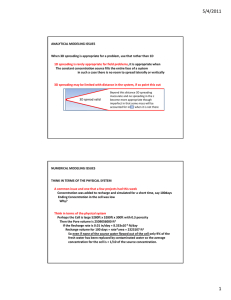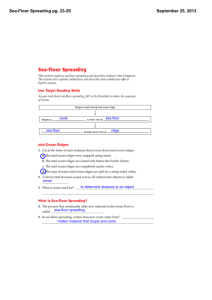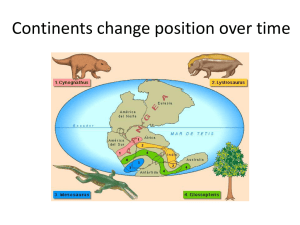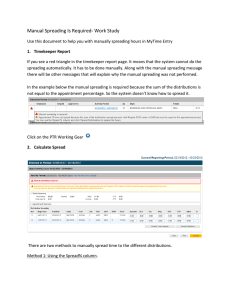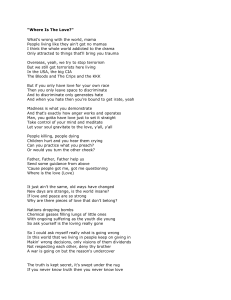Document 13940454
advertisement
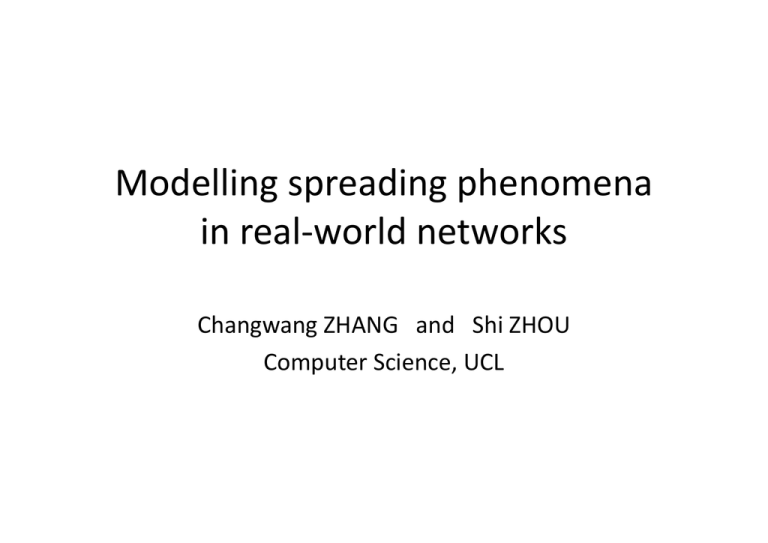
Modelling spreading phenomena in real-­‐world networks Changwang ZHANG and Shi ZHOU Computer Science, UCL Spreading phenomena • Widely exist in the real world – Computer virus in the Internet – Epidemics in human populaGon – InformaGon disseminaGon in society • AdverGsement campaign • Riot incitement via tweeter, facebook etc. ExisGng models • A popular example: SIR model – SuscepGble, InfecGous, Recovered – Sound mathemaGcal theories – Convenient for simulaGon experiments • Purpose: to predict and control spreading Problems of exisGng models • Too simplisGc • Consider only one spreading process on one network Spreading phenomena in real-­‐world networks • Much more complex • OOen involve mulGple spreading processes on mulGple networks – Happen simultaneously – Interact with each other Example 1 -­‐ Epidemics • SARS Example 1 -­‐ Epidemics • SARS – Local spreading • following human mobility paQerns within communiGes and ciGes – Lots of accidental contacts • Shall we immunise the whole populaGon? – Global spreading • via the global aviaGon network – long-­‐haul flights, well-­‐defined structure • Shall we cancel all flights? Example 2 – Computer Virus • CodeRed Example 2 – Computer Virus • CodeRed – Global spreading • 1/8 of the Gme it probes a completely random IP address – Local spreading • The rest of the Gme it probes local IP addresses (with the same 24-­‐bit or 16-­‐bit prefixes) – Both processes are needed for an successful aQack Example 3 -­‐ AdverGsement • Local spreading – Word of mouth: gossip, Tweeter and Facebook • Infect friends/followers via social networks • Global spreading – BroadcasGng and publishing: TV, Radio, the Web • Accidental, anyone can be informed • The two processes feed into each other. Real-­‐world scenarios • MulGple spreading processes – Targeted spreading following network structures – Accidental spreading via universal access • On mulGple networks – Overlapped or parGally overlapped networks – Networks at different granularity • InteracGons – Between spreading processes – Between networks A new spreading model • StarGng with a typical scenario – Two processes on two overlapped networks • Local spreading following a network structure – Power-­‐law network topology • Global spreading with random, universal access – Similar to the adverGsement campaign – Independent, simultaneous and interacGve TheoreGcal analysis • If the parameters of the spreading processes saGsfy the criGcal threshold • then the final size of an outbreak (in an infinite network) can be predicted as • otherwise the outbreak size approaches to zero, meaning the epidemic is ephemeral. The criGcal threshold InfecGon rate of local spreading Recovery rate The raGo of local infecGon rate (beta1) to the global infecGon rate (beta2). The percentage of local spreading, i.e. the percentage of global spreading is 1 – alpha. Previous models are equivalent to special cases of our model (when alpha is zero or 1). The node average degree, i.e. the average number of connecGons a node has in the local spreading network. SimulaGon results 1 0.9 0.8 Outbreak size 0.7 0.6 0.5 SimulaGon 0.4 Theory 0.3 0.2 0.1 0 0 0.1 0.2 0.3 0.4 0.5 alpha 0.6 0.7 0.8 0.9 1 Challenges and future work • To study other measures and other parameters. • To extend the model to more general scenarios. • To improve the accuracy of predicGons. • To explore real applicaGons. CollaboraGon • We call for collaboraGon – Real-­‐world case study – TheoreGcal analysis • In parGcular we need real datasets – Can you help? Thanks Changwang ZHANG c.zhang@cs.ucl.ac.uk Shi ZHOU s.zhou@ucl.ac.uk
